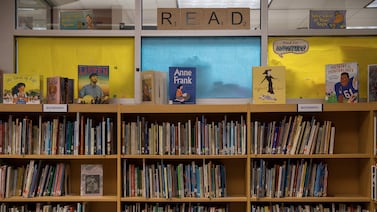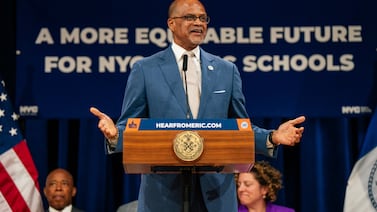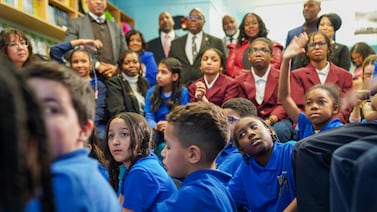Sign up for Chalkbeat New York’s free daily newsletter to get essential news about NYC’s public schools delivered to your inbox.
A first-of-its kind initiative to expand access to student journalism in New York City public schools announced its inaugural class of 30 high schools on Friday.
The high schools, which span all five boroughs, will receive professional development and a new curriculum to start journalism courses starting next year through Journalism for All. They will also get seed funding and ongoing support to launch school publications, and paid media internship opportunities for students in future years.
Journalism For All launched earlier this year to address long-standing gaps in access to journalism in city schools, after years of work from youth advocates and nonprofits.
Only a quarter of the more than 400 high schools across the city had an active student publication as of 2022, the survey from Geanne Belton, a journalism professor at CUNY’s Baruch College found. Schools with higher concentrations of Black, Latino and low-income students, and those located in Brooklyn and the Bronx were less likely than other schools to have publications.
Selecting the inaugural cohort marks the first major step towards realizing that goal — and an early test of the initiative’s theory that schools are eager to expand journalism offerings, but just need more support and guidance, organizers said.
“I think the application process really demonstrated how these opportunities are in such high demand across the city,” said CJ Sánchez, the director of the Youth Journalism Coalition, which oversees the initiative and is directed by The Bell, a nonprofit focused on youth audio journalism. (The Bell partners with Chalkbeat on the P.S. Weekly podcast.)
Journalism For All secured financial support from local lawmakers and several foundations, including the Charles H. Revson Foundation, and hopes to eventually get funding from the city. (Revson supports a CUNY journalism student summer intern at Chalkbeat.)
A total of 55 schools applied for the 30 available spots, Sánchez said. Another 60 expressed interest, but couldn’t satisfy the requirements of the application, including carving out the scheduling room and personnel to run a journalism class next year, Sánchez added.
Nineteen of the 30 schools selected for the first Journalism For All cohort are in the Bronx and Brooklyn, and the schools have an average student poverty rate of 84%, higher than the city’s average of 75%.
One of those schools is Park Slope Collegiate, a small high school on the John Jay campus in Park Slope, Brooklyn.
Autumn Wynn is a junior at Park Slope Collegiate who’s been involved in journalism through outside organizations but hasn’t had a chance to take a journalism course or work for a publication at her school. She was overjoyed to hear the news.
“Journalism For All not only will not help writing skills overall, but it will also help with a necessary need as a human in the world: advocacy skills,” she said.
Wynn said her classmates complain all the time about things they want to change in the school, but often don’t feel like they have a forum or platform to act on it. With access to a publication, they’ll have an “opportunity to not only do something about it, but they get discovered. They can find their passions, and someone can see their talent.”
Journalism initiative will support internships, student curriculum
Organizers are particularly hopeful that the first cohort can expand journalism access to students with disabilities.
One of the participating schools, P.S.811M, the Mickey Mantle School in Manhattan, is part of the city’s District 75 for students with complex disabilities. And five others have specialized programs for students with disabilities, program organizers said. Several of the teachers planning to lead the journalism courses next year are special education teachers, Sánchez added.
Another participating school, ATLAS, formerly called Newcomers High School, is geared explicitly toward recently-arrived immigrants.
The funding, training and support for schools in this year’s cohort will last for three years. Organizers said that’s key to ensuring that schools can sustain the journalism programs they launch.
Journalism For All hopes to give students’ efforts staying power by creating publications that are “embedded in the school culture … where the faculty are getting interviewed by the students, where they’re reading the publication, where it’s widely accessible and distributed,” Sánchez said.
The initiative has several core components. First, a teacher at each school in the cohort will participate in regular training through this spring and summer with staff at CUNY’s Newmark Graduate School of Journalism, and get access to a curriculum to help launch journalism classes at their schools next year.
Principals in participating schools have committed to reducing those teachers’ course loads so that the new journalism course won’t come as an extra responsibility, said Sánchez. Some schools will offer the class five days a week and use it to satisfy English Language Arts requirements, while others will offer it as an elective less frequently.
In the second year of the program, City Council members have committed to providing seed funding to help schools cover the startup costs of launching a publication, including equipment and extra pay for teachers staying after school, Sánchez said. The council passed a resolution in August urging the city to expand youth journalism access.
Schools will then partner with nonprofits with expertise in print, audio, and broadcast journalism for youth to help build out their student publications.
The program will also fund paid student journalism internships at outside publications, organizers said.
Sánchez hopes the initiative can provide a template for the city Education Department to expand journalism access to all 400-plus high schools. Organizers are working with researchers at NYU to do an independent evaluation and plan to meet with Education Department officials next month to share their progress.
Wynn, the Park Slope Collegiate junior, is “so sad” that much of the initiative won’t come to fruition at her school until after she graduates. But she’s close with a number of freshmen and sophomores and said “so long as it’s good for them and the rest of the cohorts that come into the school, I can’t be that mad.”
Below is the full list of schools in the first Journalism For All cohort:
A School Without Walls
ATLAS High School
Bronx Haven High School
Brooklyn Emerging Leaders Academy
Brooklyn Academy of Science and the Environment
Brooklyn Institute for Liberal Arts
Civic Leadership Academy
East Bronx Academy for the Future
El Puente Academy for Peace and Justice
Fannie Lou Hamer Freedom High School
Gotham Collaborative High School
Gotham Professional Arts Academy
Gotham Tech High School
High School for Excellence and Innovation
High School for Global Citizenship
High School of Telecommunication Arts & Technology
John Adams High School
John Dewey High School
Laboratory School of Finance and Technology
Lower East Side Prep
Lyons Community School
P811M@499 The Mickey Mantle School
Park Slope Collegiate
Port Richmond High School
Teachers Preparatory High School
The Young Women’s Leadership School of The Bronx
Urban Assembly Maker Academy
Urban Assembly School for Music and Art
United Charter for the Humanities
West End Secondary School
Michael Elsen-Rooney is a reporter for Chalkbeat New York, covering NYC public schools. Contact Michael at melsen-rooney@chalkbeat.org






